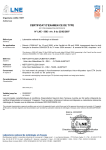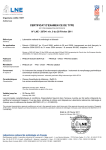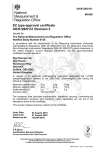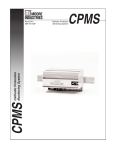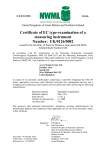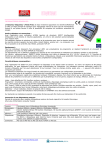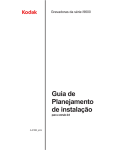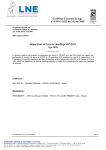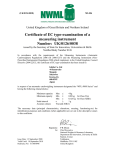Download 6990-0
Transcript
CIM2-V0-02-2007 Organisme notifié n°0071 Notified body CERTIFICAT D'EXAMEN CE DE TYPE EC TYPE EXAMINATION CERTIFICATE N° LNE - 6990 rév. 0 du 15 juin 2007 Délivré par : Laboratoire national de métrologie et d'essais Issued by En application In accordance with : Décret n°2006-447 du 12 avril 2006, et de l'arrêté du 28 avril 2006, transposant dans le droit français la directive 2004/22/CE du 31 mars 2004 In accordance with Décret n°2006-447 du 12 avril 2006, et de l'arrêté du 28 avril 2006, transposant dans le droit The decree nr 2006-447 dated 12 April 2006 and the order dated 28 April 2006, transposing in the French law the council directive 2004/22/EC of 31 Mars 2004 The decree nr 2006-447 dated 12 April 2006 and the order dated 28 April 2006, transposing in the French law the council Délivré à : ASCOREL rue du Champ de Courses FRA 38780 PONT EVEQUE Issued to Fabricant : ASCOREL - rue du Champ de Courses - FRA - 38780 - PONT EVEQUE Manufacturer Concernant In respect of : Un instrument de pesage à fonctionnement automatique trieur-étiqueteur type MC 402 intégré sur chargeuses à godet An automatic catchweighing instrument type MC 402 to be incorporated in front-end loaders Caractéristiques Characteristics : Classe d'exactitude : Y(b) Classe d'environnement climatique : - 10 °C ; + 40 °C Les autres caractéristiques figurent en annexe Accuracy class : Y(b) Climatic environment class : - 10 °C ; + 40 °C Other characteristics are given in the annex Valable jusqu'au Valid until : 15 juin 2017 June 15th, 2017 Les principales caractéristiques et conditions d'approbation figurent dans l'annexe ci-jointe qui fait partie intégrante du certificat d'approbation et comprend 10 page(s). Tous les plans, schémas et notices sont déposés au Laboratoire national de métrologie et d’essais sous la référence de dossier DDC/22/G090543 The principal characteristics, approval conditions are set out in the appendix hereto, which forms part of the approval documents and consists of 10 page(s). All the plans, shematic diagrams and documentations are recorded by Laboratoire national de métrologie et d'essais under reference file DDC/22/G090543 Etabli le 15 juin 2007 Issued on June 15th, 2007 Pour le Directeur Général On behalf of the General Director Laurence DAGALLIER Directrice Développement et Certification Business Development and Certification Director ANNEXE AU CERTIFICAT (Annex to the certificate) LNE n° 6990 rev.0 Cette annexe est bilingue ; le texte original est en français. En cas de problèmes (juridiques), se référer au texte français Aucune réclamation ou aucun droit ne peut provenir de la traduction. This annex is bilingual ; original wording in French language. By (legal) problems refer back to the text in French language. No legal claims or duties can be derived from the translation Les instruments doivent correspondre aux spécifications suivantes. The instruments shall correspond with the following specifications. 1 Désignation du type Type designation « MC 402 HTC » . “MC 402 HTC” . D’autres appellations commerciales peuvent être utilisées. Other trading designations may be used. 2 Description Description 2.1 Construction Construction L’instrument de pesage à fonctionnement automatique trieur-étiqueteur MC 402 HTC, ci-après dénommé "instrument", est destiné à être intégré dans les chargeuses à godet. Il permet la pesée individuelle de charges de matériau pendant un chargement. The automatic catchweigher type MC 402 HTC - hereafter called “instrument” - is designed to be incorporated in front-end loaders. It allows individual weighing of loads of loose material during loading. L’opération de pesage se fait en mode dynamique ; le godet chargé est pesé lors de la levée avant sa décharge. Toutefois, il peut également être réalisé en mode statique pour la dernière pesée composant un chargement. Le résultat d’un chargement est la somme calculée des pesées individuelles. The weighing function is performed in dynamic mode ; the loaded bucket is weighed during going up before it is unloaded. However, it may also be performed in static mode for the last load to be included in a loading. The result of a loading is the calculated sum of the individual weighings. L'instrument est constitué par les éléments suivants. a/ un dispositif récepteur de charge constitué par le godet. b/ Un dispositif équilibreur et transducteur de charge constitué par deux capteurs de pression. c/ Deux détecteurs de position définissant la fenêtre de pesage. d/ Un détecteur de positions du godet permettant d’assurer que le déchargement du godet pesé a eu lieu avant de commencer la pesée suivante et aussi d’assurer que le godet rechargé est en position adéquate pour être pesé. e/ Un boîtier de raccordement pour les capteurs de pression et les détecteurs de position incluant le dispositif unité de traitement des données analogiques ; ce boîtier est dénommé « boîtier d’acquisition » dans la suite de cette annexe. f/ Un dispositif terminal type boîtier afficheur MC 402 HTC incluant le dispositif unité de traitement de données numériques. g/ Un dispositif imprimeur connecté permettant notamment d’imprimer la somme calculée des pesées individuelles ainsi que le nombre de pesées individuelles et les valeurs des pesées individuelles. The instrument is composed of the following parts. a/ a load receptor composed of the bucket. b/ A load transducer made of two pressure sensors. c/ Two position sensors defining the weighing window. d/ A positions sensor of the bucket allowing insurance that the unloading of the bucket has taken place before beginning the next weighing and also allowing insurance that the re-loaded bucket is in appropriate position to be weighed . e/ A connexion box for pressure and positions sensors including the analogic data processing unit ; this box is hereafter called “acquisition box”. f/ A terminal device type display panel MC 402 HTC including the digital data processing unit. g/ One connected printer allowing in particular the printing of the calculated sum together with the number and the values of the individual weighings. Page 1 / 10 ANNEXE AU CERTIFICAT (Annex to the certificate) LNE n° 6990 rev.0 2.2 Capteur de mesure Measurand sensor Le capteur de mesure est un capteur de pression comportant les inscriptions « ASCOREL 217P00100 » et dont le type a fait l’objet d’essais selon la recommandation R 60/2000 de l’OIML. The measurand sensor is a pressure sensor having the inscriptions “ASCOREL 217P00100” and whose type has been tested according to the OIML recommendation R60/2000. 2.3 Processus de pesage Measuring process Le conducteur de la chargeuse entre un objectif de chargement (poids cible total) 1/ Avant toute nouvelle opération de chargement, une mise à zéro est imposée au conducteur de la chargeuse qui doit suivre les instructions affichées. Lorsque les opérations de mise à zéro se sont correctement déroulées, le chargement peut commencer. 2/ Le conducteur de la chargeuse charge le godet en le manipulant au-dessous de la fenêtre de pesage. Deux possibilités existent décrites aux points 2.1/ ou 2.2/ ci-après. 2.1/ Le conducteur de la chargeuse commande la montée du godet. Lorsque le premier détecteur de position de la fenêtre de pesage est atteint, la pesée dynamique commence et se termine lorsque le second détecteur de la fenêtre de pesage est dépassé. Si les critères de stabilité de la mesure sont satisfaits et si la position du godet est détectée comme satisfaisante, la pesée est validée et le godet est déchargé. 2.2/ Le conducteur de la chargeuse ajuste la charge dans le godet de manière à obtenir une charge donnée (ceci est par exemple utilisé lors de la pesée du dernier godet qui composera le chargement). L’obtention de la valeur souhaitée peut nécessiter une ou plusieurs pesées réalisées en mode statique (dans le cycle automatique) de manière à ce que le conducteur de la chargeuse puisse retirer ou ajouter du produit dans le godet jusqu’à ce que la charge soit adéquate. Lorsque la charge est adéquate, les critères de stabilité de la mesure satisfaits et la position du godet détectée comme satisfaisante, la pesée est validée et le godet est monté jusqu’à sa position de déchargement puis il est déchargé. 3/ Dans les cas où les critères de stabilité de la mesure ne sont pas satisfaits ou si la position du godet est détectée comme non satisfaisante, un messa ge visuel est affiché par l’instrument signalant que la pesée n’est pas prise en compte et que le conducteur de la chargeuse doit redescendre le godet de manière à refaire une pesée. Cette étape 3/ est à répéter tant que la pesée n’est pas acceptée. 4/ Lorsque la pesée est acceptée, le godet est déchargé. La valeur pesée est additionnée dans la mémoire où est totalisée la masse de produit chargée. 5/ Le conducteur de la chargeuse redescend le godet et recommence à partir de l’étape 2/. 6/ Lorsque le chargement est terminé, une impression de l’opération de chargement est commandée. Plusieurs demandes d’impression de cette opération peuvent être commandées de manière à obtenir des duplicata du ticket (mêmes données, mêmes références, mêmes date et heure). Il n’est plus possible d’imprimer ces données dès qu’un nouveau chargement a commencé The loader’s driver of the loader enters a target (total target weight) 1/ Before any other new loading sequence, a zero setting is imposed on the loader’s driver who has t o follow the instructions displayed. When zero setting is correctly finished, the loading sequence may begin. 2/ The loader’s driver loads the bucket working under the weighing window. Two possibilities exist described in following paragraphs 2.1/ or 2.2/ 2.1/ The loader’s driver makes the bucket go up. When the first position sensor of the weighing window is reached, dynamic weighing begins and stops when the second detector is passed. If the stability criteria are fulfilled and if the bucket’s position is detected as correct (from the position sensor of the bucket), the weighing is validated and the loader’s driver can discharge the load from the bucket. 2.2/ The loader’s driver to adapt the load in the bucket in order to get a load of a hoped value (this is for example the Page 2 / 10 ANNEXE AU CERTIFICAT (Annex to the certificate) LNE n° 6990 rev.0 3/ 4/ 5/ 6/ case when weighing the last bucket taken into account in the total). The operation may then include one or more weighings performed in static mode (during the automatic cycle) to allow the loader’s driver to remove or to add product in the bucket in order to get an appropriate value of the load. When the load is suitable and the stability criteria are satisfied and the bucket’s position detected as correct, the weighing is validated and the drivers makes the bucket go up to its unloading position and discharges the load from the bucket. If the stability criteria are not fulfilled or if the bucket’s position is detected as not correct, a visual message is displayed indicating that the this weighing is not taken into account and that the loader’s driver has to make the bucket going down in order to perform a new weighing. This step 3/ has to be repeated as long as the weighing is not accepted. When the weighing is accepted the load is discharged from the bucket. The weighed value is added to the memorised total load. The loader’s driver makes the bucket go down and starts from step 2/ When the loading is finished, a printing is ordered. Several duplicates of the ticket may be ordered (same data, same references, same date and time) . No other ticket with these data is possible when a new loading has begun. 2.4 Indication de la valeur pesée Measurement value indicator L’indication de la valeur pesée est affichée sur la face avant du boîtier du module terminal. L’écran est de type LCD (cristaux liquides) monochrome ou couleur et est accompagné d’un clavier et de touches de commande (voir photographie 1). Indication of the weighed value is displayed on the front of the terminal device’s front. The screen is LCD (liquid crystal display) monochrome or colour and is accompanied with a keyboard and control commands as illustrated hereafter (see photograph 1). Photographie 1 Photograph 1 2.5 Équipements et fonctions soumis aux exigences de la directive 2004/22/CE Equipments and functions subject to MID requirements Équipements - Le module terminal comporte des interfaces de communication (voir 4). Equipments - The module “terminal” has communication interfaces (see 4). Page 3 / 10 ANNEXE AU CERTIFICAT (Annex to the certificate) LNE n° 6990 rev.0 Fonctions Functions - Dispositif de chauffage du système de levage hydraulique En fonction de la durée pendant laquelle le système de levage hydraulique est resté immobile, un déclenchement d’une mise à zéro ou d’une pesée ne peut pas se produire sans qu’il y ait eu, en fonction de la durée d’immobilité : * au moins 10 montées/descentes du godet si la durée est supérieure ou égale à 1 heure * au moins 8 montées/descentes du godet si la durée est comprise entre 45 minutes inclus et 1 heure * au moins 5 montées/descentes du godet si la durée est comprise entre 30 minutes inclus et 45 minutes * au moins 2 montées/descentes du godet si la durée est comprise entre 15 minutes inclus et 30 minutes Le but est que la température du fluide du système hydraulique atteigne une valeur minimale de fonctionnement. Aucune montée/descente du godet n’est nécessaire pour une durée inférieure à 15 minutes. Warm-up of the hydraulic lifting device depending on the period of time during which the hydraulic lifting device has been motionless, a release of a zero setting or a weighing can’t occur unless there has been, d epending of the period of time the device has been motionless : * at least 10 lifting/going down of the bucket when the period is equal or greater than 1 hour * at least 8 lifting/going down of the bucket when the period is between 45 minutes included and 1 hour * at least 5 lifting/going down of the bucket when the period is between 30 minutes included and 45 minutes * at least 2 lifting/going down of the bucket when the period is between 15 minutes included and 30 minutes. The aim is that the temperature of the fluid of the hydraulic lifting device reaches a minimum operating value. No lifting/going down of the bucket is necessary when the period is lower than 15 minutes. - Mise à zéro ; l’instrument est équipé : * d’un dispositif de mise à zéro initial dont l’étendue est de 20 % de Max (peut être inhibé) * d’un dispositif semi-automatique de mise à zéro dont l’étendue est de 4 % de Max ; opération imposée au départ de tout nouveau chargement (voir paragraphe 2.3) Zero setting ; the instrument has : * an initial zero setting, the range of which is 20 % of Max (may be inhibited) * a semi -automatic zero setting, the range of which is 4 % of Max ; this function is forced at the beginning of new loading (see paragraph 2.3). - Réglage dynamique : l’instrument est équipé d’un dispositif de réglage dynamique valide sur toute l’étendue de pesage et mis en œuvre selon les instructions écrites du fabricant. Ce dispositif, protégé par le dispositif de scellement, est non accessible à l’utilisateur. Dynamic setting : the in strument is equipped with a dynamic setting facility valid over the whole weighing range and operated according to the manufacturer’s written instructions. This facility, protected by the sealing device, is not available to the user. - Logiciel Au regard du guide 7.2 de WELMEC, l’instrument est de type « P » (conçu et fabriqué spécialement pour l’usage décrit dans ce certificat) ; aucune des extensions prévues par le guide n’est utilisée. - Software From Welmec 7.2 guide, the instrument is type “P” (Built-for-purpose measuring instrument) ; none of the extensions of the guide is used. 2.6 Documentation technique (Liste des documents du fabricant sur lesquels ce certificat est basé) Technical documentation (List of technical documents of the manufacturer on which this certificate bases) 1 2 3 4 5 6 7 8 Demande Description générale de l’instrument de mesure Plans de conception Plans de Fabrication Procédés de fabrication Logiciel Manuels Normes Page 4 / 10 ANNEXE AU CERTIFICAT (Annex to the certificate) LNE n° 6990 rev.0 9 Scellements et marquages 1 Application 2 General description of the measuring instrument 3 Designing drawings 4 Manufacturing drawings 5 Manufacturing processes 6 Software 7 Manuals 8 Standards 9 Sealings and markings 2.7 Équipements intégrés et fonctions non soumis à MID Integrated equipment and functions not subject to MID D’autres équipements ou fonctions non concernés par la directive peuvent être adjoints à l’instrument. Other equipments or functions not subject to MID may be attached to the instrument. 3 Caractéristiques Technical data 3.1 Conditions assignées de fonctionnement Rated operating conditions * Classe d’exactitude (accuracy class) * Classe d’environnement climatique (Climatic influence class) * Classe d’environnement mécanique (Mechanical influence class) * Classe d’environnement électromagnétique (Electromagnetic influence class) * Portée maximale (maximum capacity) * Échelon (scale division) * Nombre d’échelons (Number of verification scale intervals) * Portée minimale (minimum capacity) Y(b) -10 °C, + 40°C Non applicable aux IPFA Not applicable to AWIs E3 Max ≥ 2 t e ≥ 20 kg 100 ≤ n ≤ 300 10 e 3.2 Autres conditions de fonctionnement Other operating conditions - - - La prise en compte d’une pesée ou d’une opération de mise à zéro ne sont possibles que lorsque le godet est levé complètement verticalement et lorsque la position de pesée (cas d’une pesée en mode statique) ou la fenêtre de pesage (cas d’une pesée en mode dynamique) sont atteintes depuis la position basse du godet. En outre, en mode dynamique, le godet doit être levé de manière constante depuis le détecteur de position inférieur au détecteur de position supérieur de la fenêtre de pesage. Au début d’un nouveau chargement, la mémoire de stockage des valeurs à imprimer est réinitialisée. Validation of a weighed value or a zero setting only possible when the bucket is completely lifted upright and when the weighing position (in case of static weighing) or the weighing window (in case of dynamic weighing) are accessed from the lower position of the bucket. In addition, for dynamic weighing, the bucket has to be lifted constantly from the lower position sensor to the upper position sensor of the weighing window. At the beginning of a new loading, the device for storing the values to print is reset. Page 5 / 10 ANNEXE AU CERTIFICAT (Annex to the certificate) LNE n° 6990 rev.0 4 Interfaces et conditions de compatibilité Interfaces and compatibility conditions Fonction (function) Type d’interface (interface type) Autre(s) information(s) (Other information(s)) Interfaces internes (internal interfaces) Connexion du boîtier d’acquisition au module « terminal » Connexion of the acquisition box to the module “terminal” Interfaces externes (external interfaces) USB Série RS 232 5 Connexions de périphériques Connexions of peripherals - - Exigences relatives à la production, à la mise en service et à l’utilisation Requirements on production, putting into use and utilization 5.1 Exigences sur la production Requirements on production Il n’y a pas d’exigence spéciale supplémentaire relative à la production. There is no additional special requirement on production. 5.2 Exigences sur la mise en service Requirements on putting into use Examens et essais - Essais Outre les examens de conformité au présent certificat, les essais doivent comporter au moins les essais suivants, réalisés sur l’instrument entièrement opérationnel installé sur la chargeuse qu’il est destiné à équiper et dans les conditions normales d’utilisation. • Excentration • Essai de pesage • Essai de dénivellement Ces essais sont réalisés en mode fonctionnement normal selon les méthodes et procédures d’essai prévues au chapitre 6 et à l’Annexe A de la R51/2006 de l’OIML. - Examen des inscriptions réglementaires Voir le paragraphe 8.1 de ce certificat - Examen de l’identification du logiciel Voir paragraphe 7 de ce certificat - Mise en place du dispositif de scellement Selon le paragraphe 7 de ce certificat Examinations and tests - Tests In addition to examination of conformity to this certificate, tests shall include at least the following tests performed on the fully operational instrument incorporated on the loader for which it is manufactured and in the normal conditions of use. • Eccentricity • Weighing test • Tilting These tests are performed in normal operation mode with the test loads for which the instrument is designed according to Chapter 6 and Annex A of OIML R51/2006. Page 6 / 10 ANNEXE AU CERTIFICAT (Annex to the certificate) LNE n° 6990 rev.0 - Examination of descriptive markings See paragraph 8.1 of this certificate - Examination of software identification See paragraph 7 of this certificate - Installation of sealing device See paragraph 7 of this certificate 5.3 Exigences pour l’utilisation Requirements for use La documentation fournie par le fabricant (manuel d’utilisation) comporte notamment : - la description des commandes à entrer pour accéder à la visualisation des versions de logiciel L’utilisateur doit assurer : - que l’instrument est et reste approprié à son usage - que les performances de l’instrument restent conformes aux tolérances réglementaires - que les scellements ainsi que les inscriptions et marquages réglementaires restent intègres - que l’instrument est conforme à la réglementation relative aux instruments en service du pays où il est utilisé - que les formats d’étiquette définis respectent les exigences réglementaires notamment celles relatives à l’impression des unités de mesure utilisées. Une intervention : - sur les vérins de levage et/ou - sur les détecteurs de position de la fenêtre de pesage et/ou - sur le détecteur de positions du récepteur de charge et/ou - sur le moteur (puissance, nombre de tours/min) et/ou - sur la pompe hydraulique et/ou - sur le système anti-tangage de la chargeuse engendre une vérification. Ceci est indiqué dans le manuel opérateur. The documentation supplied by the manufacturer (user’s manual) includes in particular : the description of commands to get access to the display of software versions The user shall insure that : the instrument is and remains appropriate for its use the performances of the instrument remain in conformity with the legal tolerances the sealing device and markings remain safe the instrument is in accordance with the regulation about control in service of the country where the instrument is used the formats of the labels are in accordance with the legal requirements, especially these related to the printing of units of measurement used. An action : on the lifting levers and/or on the position sensors of the weighing window and/or on the positions sensor of the bucket and/or on the engine (power, number of cycles/min) and/or on the hydraulic pump and/or on the anti-pitching device, leads to a verification. This is mentioned in the user’s manual. Page 7 / 10 ANNEXE AU CERTIFICAT (Annex to the certificate) LNE n° 6990 rev.0 6 Inspection des instruments en service Inspection of measuring instruments in use 6.1 Documents pour l’inspection Documents for inspection - Copie du présent certificat Manuel d’utilisation - Copy of this certificate User’s manual - 6.2 Équipement pour l’inspection Equipment for inspection - - Les charges d’essai sont constitués par des masses et/ou poids étalons conformes à la législation nationale et dont l’utilisation ne conduit pas à une erreur supérieure au tiers de l’erreur maximale tolérée sur l’instrument à vérifier. Un inclinomètre doit permettre l’évaluation du dénivellement lors des essais de dénivellement Test loads are composed of standard weights or masses which are in conformity with national legislation and the use of which doesn’t lead to an error greater than one third of the maximum permissible error of the instrument under verification. A tilt indicator shall allow evaluation of tilt for the tilt test. 6.3 Identification Identification Matériel L’instrument est désigné selon le paragraphe 1 de ce certificat. Logiciel A la mise sous tension, un contrôle de l’intégrité des parties de logiciel implantées est réalisé par calculs des sommes de contrôle correspondantes. Les valeurs sont les suivantes. - BOÎTIER AFFICHEUR * Module « TDB » : 72DB * Module « BOOT » : 38CC * Module « USB » : 0190 - BOÎTIER ACQUISITION * Module « NOEUD » : 6F20 * Module « BOOT » : 5AC3 On accède à la visualisation de ces valeurs en partant de la page principale, en sélectionnant « MENU » et ensuite « Page TEST ». Hardware The instrument is designated as written in paragraph 1 of this certificate. Software After switch-on, the integrity of the parts of embedded software is checked through calculation of the corresponding checksums. The values of these checksums are given hereafter. - - DISPLAY BOX * Module « TDB » : * Module « BOOT » : * Module « USB » : ACQUISITION BOX * Module « NOEUD » : * Module « BOOT » : 72DB 38CC 0190 6F20 5AC3 To display these values, from the main page, select “MENU” and then “ Page TEST” Page 8 / 10 ANNEXE AU CERTIFICAT (Annex to the certificate) LNE n° 6990 rev.0 7 Mesures de sécurité Security measures - - Scellement au niveau du boîtier d’acquisition (voir illustration n°1) Scellement au niveau du boîtier du module terminal pour éviter l’accès au cavalier empêchant les modifications des réglages et paramètres (voir illustration n°2) Reconnaissance croisée du boîtier d’acquisition et du boîtier du module terminal : le boîtier d’acquisition et le boîtier du module terminal sont liés par une reconnaissance croisée empêchant notamment la connexion d’un autre boîtier terminal. Ceci rend le scellement de la connexion entre les 2 boîtiers inutile. La reconnaissance croisée est le numéro de série du Boîtier Afficheur, visible dans la page TEST avec les valeurs de contrôle. Sealing of the acquisition box (see illustration n°1) Sealing of the terminal box to avoid access to the strap which prevents against changes of settings and parameters (see illustration n°2) Cross reference between the acquisition box and the terminal box : the acquisition box and the terminal box are bound by a cross reference which prevents in particular connection of another terminal box. This makes a sealing of the connection between the 2 boxes unnecessary. The cross -reference is the serial number of the Display Box, and it is displayed in the TEST page with the values of the checksums. Illustration n°1 – Scellement au niveau du boîtier de connexion Sealing of the acquisition box Etiquette de scellement Sealing sticker Illustration n°2 Vue latérale du boîtier terminal Etiquettes de scellement Une sur chaque face latérale Page 9 / 10 ANNEXE AU CERTIFICAT (Annex to the certificate) LNE n° 6990 rev.0 8 Marquage et inscriptions Labelling and inscriptions 8.1 Inscriptions réglementaires Descriptive markings Les inscriptions réglementaires sont : - nom ou marque d'identification du fabricant - numéro de série et désignation du type de l'instrument - tension de l'alimentation électrique, en V - numéro du présent certificat - classe d'exactitude sous la forme Y(b) - échelon de vérification et échelon sous la forme « e = d = … » - portée maximale sous la forme « Max = … » - portée minimale sous la forme « Min = … » Ces inscriptions figurent sur une étiquette destructible par arrachement située sur la face arrière du boîtier terminal. The descriptive markings are : - name or identification mark of the manufacturer - serial number and type designation of the instrument - power supply voltage in V - number of this certificate - accuracy class in the form Y(b) - verification scale interval and scale interval in the form : “e = d = …” - maximum capacity in the form : “Max = …” - minimum capacity in the form : “Min = …” These markings are on a sticker not removable without being destroyed located on the back side of the terminal box. 8.2 Marquage de conformité Le marquage prévu aux paragraphes 1, 2, 3 et 5 de l’article 19 de la directive 2004/22/CE figure dans le voisinage des inscriptions réglementaires. The markings meant in paragraphs 1, 2, 3 and 5 of article 19 of directive 2004/22/EC are in the vicinity of the descriptive markings. Page 10 / 10











